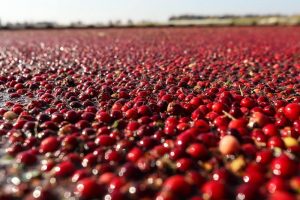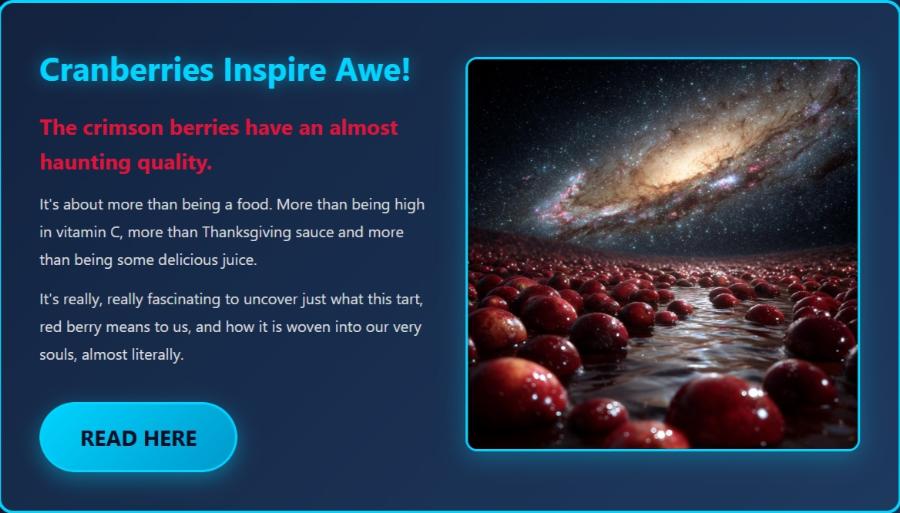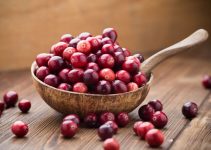
Cranberry Nutrition Data
What’s inside a cranberry.
Cranberry (Fresh) Nutrition Facts
Serving Size: 1 cup chopped (110 g)
Calories: 50
MACRO NUTRIENTS
Carbs: 13 g
Protein: 0.5 g
Fat 0.0g
(Sugars: 4 g)
Fiber: 5 g
VITAMINS
Vitamin C: 24% RDA
Vitamin E: 7% RDA
Vitamin K: 7% RDA
*** Cranberries contain more vitamins that what’s listed above but in negligible amounts.
MINERALS
Manganese: 20% RDA
Potassium: 3% RDA
Copper: 3% RDA
*** Just like with vitamins, cranberries contain more minerals but in negligible amounts.

Cranberry Bog
So here are some of the highlights on the data above for fresh cranberries. You can see right off the bat that cranberries are great source of vitamin C. Makes sense since they were used to treat scurvy when the settlers arrived many hundreds of years ago.
We also see that they contain 13 g of carbohydrate which is a macronutrient people are trying to avoid these days. 13 g isn’t that bad especially since it’s for an entire cup of cranberries. Now I included fiber in that category because fiber counts as a carb when people are making up nutrition tables for various foods. That means that a cup of cranberries really only contains 8 g of carbohydrate.
Furthermore, of those 8 g, only 4 of them are made up of simple sugars (most berries like blackberries, blueberries and strawberries contain more). These sugars are made up of glucose, a little bit of sucrose (table sugar) and fructose. Reason why that’s important is because fruit sugar (fructose) doesn’t act like regular sugar in our bloodstream in that it doesn’t spike our insulin as much.
Fresh cranberries are also approximately 90% water. So when you’re eating this nutritious berry you’re taking in mostly water, fiber, vitamins, minerals, polyphenols, a little bit of protein and a small bit of carbohydrate.
It’s a power packed super food that is great for your health and for your palate.
Just don’t equate the benefits of these fresh cranberries with their dried counterparts.

Dried Cranberries Nutritional Data
Dried Cranberries Nutrition Facts
Serving Size: 1 cup (120 g)
Calories: 369
MACRO NUTRIENTS
Carbs: 100 g
Protein: 0.0 g
Fat 1.5 g
(Sugars: 78 g)
Fiber: 6 g
VITAMINS
Vitamin C: 0% RDA
Vitamin E: 6% RDA
Vitamin K: 6% RDA
MINERALS
Manganese: 15% RDA
Potassium: 0% RDA
Copper: 6% RDA
Dried cranberries are processed and sweetened and are a completely different food from what they started out as.
You’ll notice right away that the vitamin and mineral content went down drastically while the sugar content went up tremendously. That is not good. It turns what used to be a nutritious, hydrating and healthy food into a sugar snack.
The water content drops down 50% and the amount of sugar went from 4 g per serving in the fresh berries, to a colossal 78 g in the dried ones. Clearly this is a desert.
I’m not saying we should never eat dried cranberries because they taste great. I am saying that any food that has a high amount of sugar in it should be consumed in moderation.

Pure Cranberry Juice
Pure Cranberry Juice Nutrition Facts
Serving Size: 1 cup (253 g)
Calories: 116
MACRO NUTRIENTS
Carbs: 30 g
Protein: 1.0 g
Fat 0.0 g
(Sugars: 30 g)
Fiber: 0 g
VITAMINS
Vitamin C: 39% RDA
Vitamin E: 15% RDA
Vitamin K: 16% RDA
MINERALS
Manganese: 0% RDA
Potassium: 6% RDA
Copper: 7% RDA
The data above is for pure cranberry juice and not the sweetened variety we generally see at the supermarket.
We see the calories and carbs increase a lot (compared to fresh cranberries) which only makes sense because pure cranberry juice is made up of multiple cups of fresh cranberries that are squeezed and compressed into juice.
When we turn the berries into juice we lose the fiber but keep many of the vitamins and minerals, except for manganese for some odd reason (perhaps that mineral is stored in the fibrous part of the berry).
Pure cranberry juice is tart and sour and most people find it difficult to drink it on its own. Rather than buying the sweetened version or adding sugar to it yourself, you can keep it nutritious by adding a can of diet 7-Up (or something similar) two 1/4 cup of pure cranberry juice. That allows the drink to be sweet without adding sugar so you get the benefits of the pure juice while also enjoying cool, refreshing and great tasting drink.

All things Cranberries at Cranby.com
…
Cranberries are an extremely nutritious berry and I would encourage everyone to add them to their diet.
One interesting historical fact is that the Native Americans used to help the settlers by having them eat the vitamin C-rich wild cranberries to help with their scurvy. It was also used at that time to help with indigestion, inflammation and as a compress on wounds.
One could talk for ages about the nutrition in cranberries but what’s outlined above are the more commonly known, and important facts about the berry. They are definitely worth trying …
… either in their raw form or in a juice. Just not dried. In their dried form they are mostly sugar which negates any health benefit you’d get.
They are great in recipes too and this blog has lots to choose from.
– Cranby




